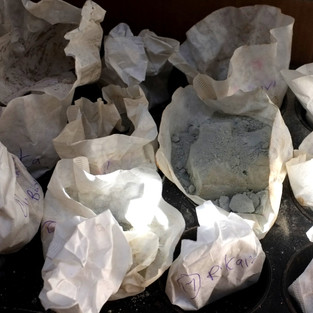Testing
- Janeen Page
- Sep 16, 2020
- 3 min read
So while it looks like I'm still travelling the country, in real-time there has been more time spent in the studio grinding and testing glazes.
The first month of the project was in the South Island of New Zealand. I had planned to do the North Island first but with the COVID alert levels dropping to level one, school holidays and isolation hotels in the central North Island, I figured doing the circuit in reverse would avoid the crowds.
Over the next few weeks, I will continue to upload more sample sites and update the blog to include final test results.

The testing process, while laborious, was relatively simple. Each of the 40 plus samples had its turn in the ball mill for between 2-24 hours depending on its density. Some samples such as the Takaka River looked like they would take forever but reduced to a slurry fast. Steve Harrison informed me that there is the chance that 24 hours in the mill may of overground some of the material and if so the test will crack, split and not adhere to the bisque ware. If this is the case I will redo these samples as I made sure to only grind small quantities in this first round.
The next step was to dry all the materials for weighing. This was probably the one thing I spent the most time agonising over. Some books I had read used wet weights but because I was using dry ash and dry whiting I couldn't see any other way than to have every sample dried also.
So after a trip to the op shop to clean out the pillowcase supplies, each sample was then placed in them to drain and hung outside to dry. During the bisque of the samples I was able to dry more on top of the kiln, and the final few made it into coffee filter bags in muffin trays in my oven overnight! This insured that my weights were consistent across the samples, but turned my studio into a state of constructive, yet controlled chaos!

The weighing was done on a small slide scale, Test A. 90% Sample with 10% Whiting, Test B. 90% Sample with 10% Ash, following Bondy's measures and using ash from my hearth that was pine, washed and sieved.
Once I get some idea of the results from this initial test I can do further line test with varying quantities. I have prepared some line sample dishes similar to Steve Harrison's palettes and look forward to taking this project beyond Bondy's initial samples.
The small test tiles that were thrown on the wheel were then labelled with iron oxide and dipped and poured to glaze. Most glazes went on well, though the beach sands, Nelson, Motueka and especially the iron sand behaved badly.
I also made small tiles in which each of the individual samples with no other ingredients were added, this will give me a control test to base further tests on.

The clay used was Temuka the same clay as Bondy used in her original samples. Sourced from New Zealand Insulators in Temuka by Grace at Ata ceramics in Lyttleton. I was so pleased to be able to work to Bondy's exact methods. I was told that it would fire to 1300 so I'm very much hoping this is the case or I will be repeating the process on something that can.
Given time and if I have enough of the initial sample materials I will also test the samples on a buff stoneware body and again on Temuka in oxidation.












Comentarios